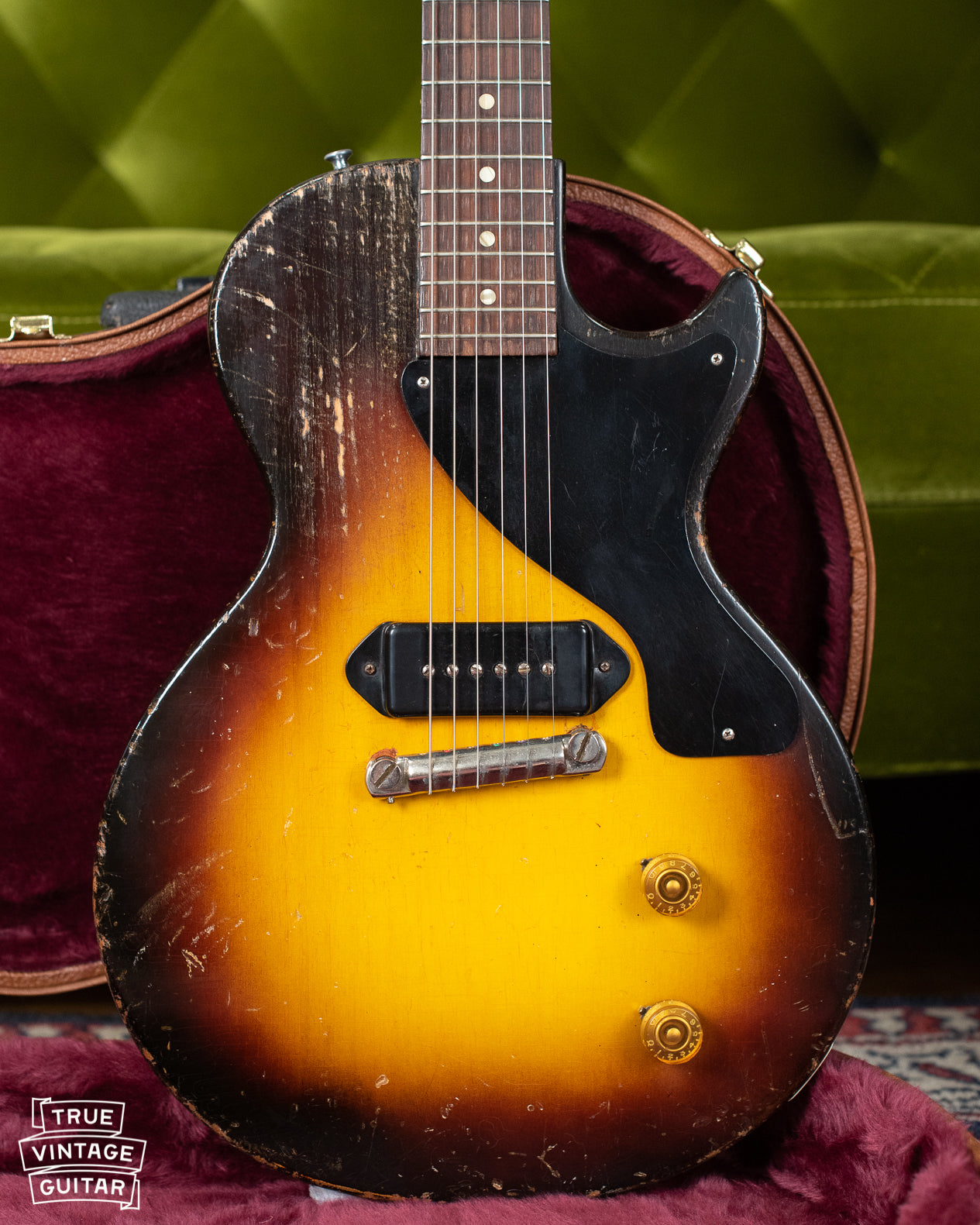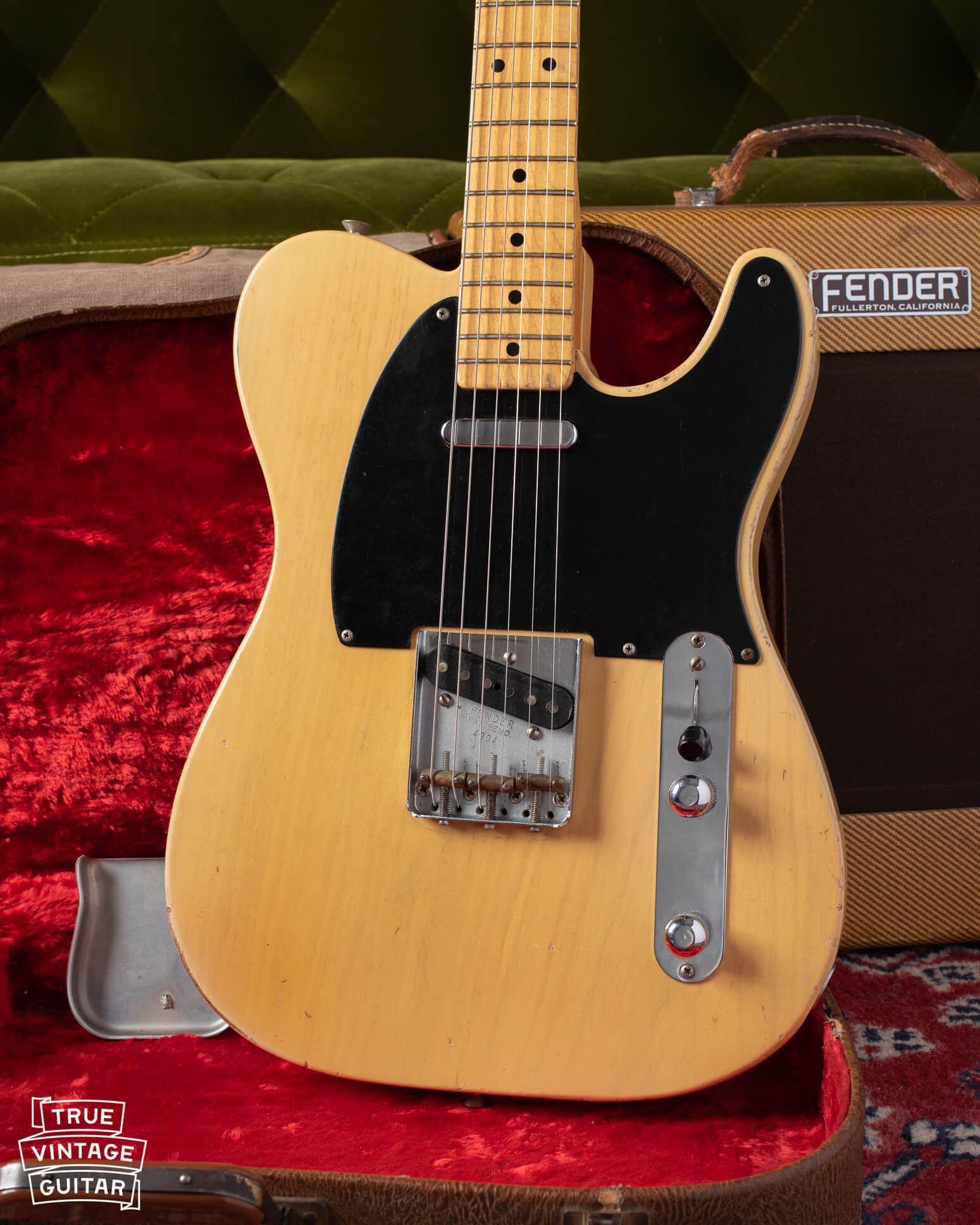This Gibson Firebird V 1965 in original Cherry Red finish came through the shop last year. The standard color for the Gibson Firebird range of guitars was Sunburst, so this example in Cherry Red is a very rare find. This Firebird V features the second version of the body styles that Gibson guitar collectors and players call "non-Reverse". The non-Reverse Firebird guitars have a neck to body joint and the bass side horn is more elongated than the treble side. As a Gibson guitar collector, I'm always on the hunt for nice examples of Gibson Firebird guitars from the 1960s. You can contact me here to sell a Gibson Firebird.
This rare Gibson Firebird V 1965 Cherry Red came to me via its original owner. He lived about an hour away from the Gibson factory in Kalamazoo, MI. He told me that he had a Gibson Firebird V before this guitar, but that the body wing delaminated from the neck at some point. He took it back to the Gibson factory and they swapped it for this guitar. I think that he probably had a Reverse Firebird V like this guitar: Gibson Firebird V 1964.
The Gibson Firebird range included four electric guitars: Firebirds I, III, V, and VII. The Firebird 1 originally featured one pickup in the bridge position and dot fretboard markers, but the second version added a second pickup. The Firebird III originally had two Firebird style mini humbuckers, but the non-Reverse version had three P-90s instead. The Firebird V always had two Firebird style mini humbucking pickups, but the second version exchanged the large trapezoid fretboard inlays for the dots. The Firebird VII or 7 was always the top of the range with gold hardware, three Firebird style mini humbucking pickups, and large pearl block style fretboard markers.
Here's a great book for more information on Gibson Firebird guitars: Flying V, Explorer, Firebird: An Odd Shaped History Of Gibson's Weird Electric guitars. Legendary guitar author Tony Bacon discusses some fabulous history of how Ray Dietrich was called in by Ted McCarty to give it a fresh look from a famous car designer. He also discusses a great anecdote about how Fender threatened a lawsuit over the guitar's shape which does remind the viewer of Fender's Jazzmaster model.

How to date a Gibson Firebird V 1965
Gibson's non-Reverse Firebird production run lasted a short life span of only 1965 until 1969, so the values for each year may not vary as much as similar models. It's still important to find the year of a Gibson Firebird guitar as a part of its inspection. The first place I would look for how to date a Gibson Firebird would be its serial number, then potentiometer codes, then check to see that the features support the date suggested by the previous two data points. If you'd like help to find the year of a Gibson Firebird, check out How to date Gibson guitars.
Gibson serial numbers pre-1975 are tricky since they are style specific, not necessarily consecutive, and they repeat multiple times in the 1960s and 1970s. Still, a skilled Gibson guitar collector can use the serial number to find the year that Gibson used the range and style. The serial number on this Gibson Firebird V Cherry Red is six digits impressed in the back of the headstock, no made in USA, and begins with 515. Our records indicate that Gibson used this serial number range and style in both 1965 and 1968.

The features of this Gibson Firebird V include a non-Reverse body style, chrome hardware, reflector style knobs, and double line Kluson tuners. The non-Reverse body style began in 1965 and was discontinued in 1969. Chrome hardware replaced nickel finished hardware in 1965. Gibson used reflector knobs from 1960 until 1967 when the witch hat style knobs replaced the wider topped reflector knobs. Double line Kluson tuners were introduced in 1964.
The potentiometer codes are often the best way to find the year of Gibson guitars. I don't have pictures of the potentiometer codes of this Firebird V 1965, but we can look at the codes from another guitar. I always check the potentiometer codes to see if the date codes support the expected year of manufacture indicated by the serial number. I don't have a picture of the potentiometer codes for this guitar, but here's another Gibson guitar with potentiometer codes we can check out: Gibson Les Paul Custom 1968. The codes on these potentiometers read "137 6745" which indicates that they were made during the 45th week of 1967.

Gibson Firebird V 1965 Values
As an active Gibson guitar collector, I am looking for the best examples of 1960s Gibson Firebird guitars. I look for clean condition, rare colors, and great playing guitars. The value of a Gibson Firebird depends on the exact model, color, and condition of the guitar. The earlier Reverse style Firebirds with neck through design are generally more valuable than the later non-Reverse style guitars with neck to body joint, but sometimes the color or condition can change that.
Gibson offered the Firebird range in custom colors. Many guitar players in the 1960s were very happy with the standard Sunburst style finish and didn't feel the need to pay extra for a custom color. There are far more examples in Sunburst than there are in any custom color, so most Gibson guitar collectors will pay more for those than a similar guitar in Sunburst. Cherry Red is an interesting color for a Firebird since it was a standard color on other models but not for the Firebird range. I've been looking for another Cherry Red Firebird since this guitar so you can contact me here if you're interested in an offer: sell a Gibson.
Sell a Gibson Firebird
I am always on the hunt for nice examples of Gibson Firebird guitars made in the 1960s. As a Gibson guitar buyer, I travel world wide to get the guitars I'm looking for. I'm looking for both Reverse and non-Reverse Firebirds but especially clean condition and custom color. You can contact me here if you're curious about the value of a Gibson Firebird: sell a Gibson.




